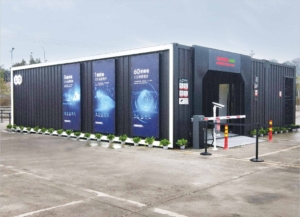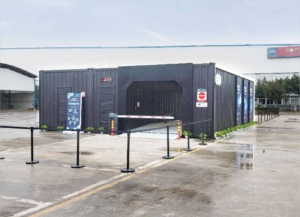https://www.tlc-yz.com/product/containerized-integration/energy-storage-container/
Choosing the right container battery for your application can be a daunting task, especially given the vast array of options available on the market today. Container batteries play a crucial role in a variety of applications, from renewable energy storage to electric vehicles and backup power systems. Understanding the specific requirements of your application is essential to selecting the appropriate battery. This article will delve into the key considerations and steps involved in choosing the right container battery, ensuring you make an informed decision.
Understanding Container Batteries
Container batteries, often referred to as modular or battery container systems, are designed for easy transport and installation. They typically house multiple battery cells and components in a single container, providing a comprehensive energy storage solution. These batteries are used in a range of applications, including:
- Renewable Energy Storage: Storing excess energy generated from solar panels or wind turbines.
- Backup Power Systems: Providing emergency power during outages for homes or businesses.
- Electric Vehicles (EVs): Supplying energy to electric cars and other forms of transportation.
- Industrial Applications: Supporting power requirements in manufacturing and other sectors.
To select the right container battery, consider the following factors:
1. Determine Your Power Requirements
Before exploring specific container batteries, it’s crucial to assess your power needs. Begin by answering the following questions:
- What is the peak power demand? Identify the maximum load your application will require. This can be expressed in kilowatts (kW) and helps determine the size of the battery system needed.

- What is the energy storage requirement? Consider how long you need the battery to provide power during peak usage. This is typically measured in kilowatt-hours (kWh).
- What is the discharge rate? Understanding how quickly you will need to draw power from the battery is essential. Some applications require rapid discharge, while others can afford a slower rate.
2. Assess Battery Chemistry
Container batteries come in various chemistries, each with its own advantages and disadvantages. The most common types include:
- Lithium-ion (Li-ion): Known for their high energy density, longer cycle life, and faster charging times. They are ideal for applications requiring compact size and lightweight solutions.
- Lead-acid: Traditional and widely used, lead-acid batteries are cost-effective but heavier and have a shorter cycle life compared to Li-ion batteries. They are suitable for applications with lower power demands.
- Nickel-metal hydride (NiMH): Typically used in hybrid vehicles and other applications, NiMH batteries offer a balance between performance and cost but are less common in large container systems.
- Flow batteries: A newer technology, flow batteries provide longer discharge durations and can be easily scaled. They are particularly suited for large-scale energy storage applications.
Consider the specific requirements of your application when evaluating battery chemistry. For instance, if weight and size are crucial, lithium-ion may be the best choice. Conversely, if upfront costs are a concern, lead-acid might be more appropriate.
3. Evaluate Container Design and Size
The physical dimensions and design of they are essential, especially if space is limited. Factors to consider include:
- Dimensions and weight: Ensure the container fits within your available space. Heavy batteries may require additional structural support.
- Accessibility: Choose a design that allows easy access for maintenance and monitoring.
- Окружающая среда: Consider whether the container will be installed indoors or outdoors. Some designs are better suited for harsh conditions, while others are optimized for indoor use.
- Scalability: If you anticipate needing additional capacity in the future, select a container battery that allows for easy expansion.
4. Consider Efficiency and Cycle Life
Efficiency is a critical factor in the overall performance of a container battery. Look for systems with high round-trip efficiency, which refers to the amount of energy that can be retrieved compared to what was put into the battery. This is particularly important for applications where energy costs are a concern.
Cycle life is another important consideration. It refers to the number of complete charge and discharge cycles a battery can undergo before its capacity significantly diminishes. Choose a container battery with a cycle life that meets your application’s demands, ensuring longevity and reduced replacement costs.
5. Safety and Regulatory Compliance
Safety is paramount when dealing with battery systems, particularly for container batteries. Evaluate the following safety features:
- Thermal management: Ensure the container battery has adequate cooling systems to prevent overheating during operation.
- Fire suppression: Look for features that reduce fire risks, such as fire-resistant materials or built-in extinguishing systems.
- Regulatory compliance: Check compliance with local and international safety regulations and standards, including certifications from organizations like UL, CE, or IEC.
6. Evaluate Manufacturer Reputation and Support
When selecting a container battery, consider the reputation of the manufacturer. Research their history, customer reviews, and product offerings. A reputable manufacturer is more likely to provide high-quality products and reliable customer support.
Additionally, evaluate the warranty and after-sales service. A solid warranty can protect your investment, and responsive support can help address any issues that arise during operation.
7. Analyze Total Cost of Ownership
While the upfront cost of a container battery is important, it’s essential to consider the total cost of ownership (TCO). This includes:
- Initial purchase price: The cost of acquiring the container battery system.
- Installation costs: Expenses associated with setting up the system, which may involve electrical work, structural modifications, or additional equipment.
- Maintenance costs: Ongoing expenses related to the upkeep of the battery system, including potential replacements or repairs.
- Energy costs: Evaluate how efficient the battery system is in terms of energy retrieval, which can impact long-term operational expenses.
By analyzing TCO, you can make a more informed decision that considers not just the purchase price but also the long-term financial implications.

8. Test and Monitor Performance
Once you have selected a container battery, it’s crucial to monitor its performance. Implement systems to track key metrics, such as charge and discharge cycles, efficiency, and overall system health. Regular monitoring can help identify potential issues before they become significant problems, ensuring the battery operates optimally throughout its lifecycle.
Conclusion
Choosing the right container battery for your application is a multifaceted process that requires careful consideration of various factors. By assessing your power requirements, evaluating battery chemistry, and considering efficiency, safety, and total cost of ownership, you can make an informed decision. Remember that they can significantly enhance your energy management capabilities, whether for renewable energy storage, backup power, or industrial applications.
In the rapidly evolving world of battery technology, staying informed about the latest developments and trends can also provide a competitive edge. As your energy needs grow, they will be a vital component of your energy strategy, ensuring reliability, efficiency, and sustainability for years to come.
CIMC TLC|XLC|RYC is a leading manufacturer of container batteries and various other standard and special logistics equipment. With years of experience in the industry, it focuses on the design, production and distribution of high-quality innovative products that meet the specific needs of customers.
If you need high-quality and innovative logistics equipment, including refrigerated containers, cold chain equipment, containerized equipment integration, modular buildings, etc., CIMC TLC|XLC|RYC is your best choice. Welcome inquiries from customers all over the world and look forward to the opportunity to cooperate with you.


